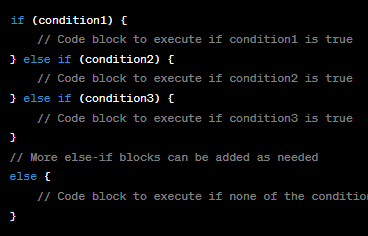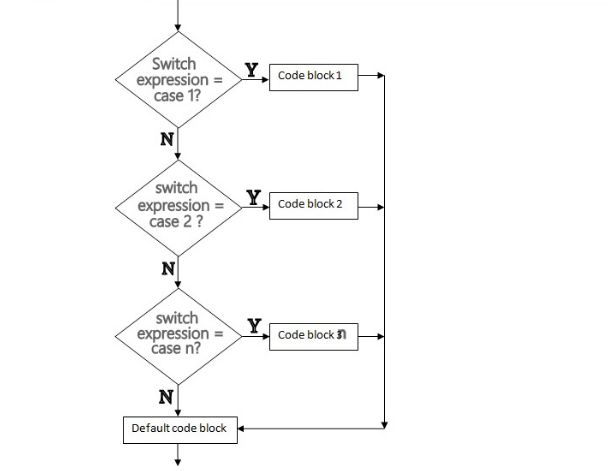When it comes to making decisions within a program, developers often face the challenge of choosing the most appropriate conditional statement. Among the popular options are the ‘Switch Case’ and ‘Else-If Ladder’ constructs.
These decision-making tools in programming play an important role in controlling the program flow based on certain conditions. However, learning when and how to use each construct optimally can certainly affect code readability, maintainability and performance.
What Is An If Ladder Statement?
The “else-if ladder,” also known as the “if-else-if-else” chain, is another control flow construct used in programming languages to make multiple conditional checks in sequence. It allows you to evaluate a series of conditions, and if any of them are true, the corresponding code block is executed. If found to be false, it continues to check the next else if ladder statement until the condition comes to be true or the control comes to end the else if ladder statement.
The syntax of an else-if ladder is as follows:

In an else-if ladder, the program evaluates each condition in order. If a condition is true, the corresponding block of code executes, and the program exits the entire if-else structure. If none of the conditions are true, the code under the else block will be executed.
The else-if ladder is useful when you have multiple conditions to evaluate, and the order of evaluation matters. Each condition is checked in sequence, and the first true condition encountered determines the execution path.
Features of An else-if-ladder
- Zero and non-zero basis is where the else if ladder depends for decision making.
- Either integer or character is the variable data type used in the expression of else if ladder.
- Each else if has its own expression or condition to be evaluated.
- Else if ladder evaluates an expression and then, the code is selected based on the true value of evaluated expression.
What Is Switch Case Statement?
The “switch case” statement is a control flow mechanism found in many programming languages, including C, C++, Java, and others. It is particularly useful when you have multiple possible values for a single variable and want to execute different blocks of code based on the value of that variable. The syntax of a switch case looks like this:

Here, the “variable” is the one whose value you want to check, and the “case” statements represent the possible values it can take. If “variable” matches a particular case, the corresponding code block is executed until it encounters a “break” statement or the end of the switch block.
The “default” case is optional and serves as the default code block to execute when none of the specified cases match the value of the variable.
Features of Switch Case
- The switch case takes decision on the basis of equality.
- Each case has a break statement.
- Integer is the only data type that can be used in switch expression.
- Each switch case will always refer back to the original expression.
- The switch statement evaluates the value of an expression and a block code is selected on the basis of that evaluated expression.
Which one to use depends on the specific situation. Use a switch case when dealing with a single variable being compared to multiple constant values. On the other hand, use an else-if ladder when dealing with multiple independent conditions, and their order of evaluation is important.
Also Read: Difference Between Switch Case And If-else
What You Need To Know About Switch Case And If-else Ladder
- Syntax:
- Switch case: It uses the ‘
switch‘ keyword followed by an expression in parentheses. Cases are defined using thecasekeyword, and the block of code for each case is enclosed within curly braces. - Else-if ladder: It uses multiple ‘
if‘ statements followed by conditions. The conditions are checked one after the other, and the block of code associated with the first true condition is executed.
- Condition evaluation:
- Switch case: The expression used in the switch statement is evaluated once, and the control jumps directly to the matching case. This means it is suitable for situations where you need to compare a single value against multiple constants.
- Else-if ladder: Each condition in the else-if ladder is evaluated one after the other until a true condition is found. This means all the conditions are checked sequentially, and the control passes through each condition, even if the earlier ones are true.
- Supported data types:
- Switch case: It can only handle integral data types (e.g., int, char) and certain enumerated types.
- Else-if ladder: It can handle any expression that evaluates to a boolean value (true or false). This includes all data types that can be used in boolean expressions.
- Expression complexity:
- Switch case: The expression inside the switch statement must result in a constant value, meaning it cannot be a complex expression or a range of values.
- Else-if ladder: The conditions in the else-if ladder can involve complex expressions, logical operations, and comparisons, allowing for more flexible conditions.
- Case matching:
- Switch case: The case values must be constant and unique. The control will jump to the first matching case and execute the code within that case. If no match is found, an optional
defaultcase can be used. - Else-if ladder: The conditions can be overlapping, meaning multiple conditions can be true for a given input, leading to multiple blocks of code being executed. The order of the conditions matters, and the first true condition is executed.
- Fall-through behavior:
- Switch case: If a case block does not end with a
breakstatement, the control will fall through to the next case and continue executing the code in that case and any subsequent ones until abreakstatement is encountered or the switch block ends. - Else-if ladder: Each
ifstatement in the ladder is independent of others, and there is no implicit fall-through behavior like in switch case.
- Readability and maintainability:
- Switch case: It is more concise and readable when dealing with multiple constant values. It can be a good choice for simple, straightforward scenarios.
- Else-if ladder: For complex conditions or ranges of values, an else-if ladder may be more readable and maintainable as it allows expressing conditions more explicitly.
- Use cases:
- Switch case: It is commonly used when you have a fixed set of values to compare against a single variable and when fall-through behavior is needed (e.g., menu options, handling weekdays).
- Else-if ladder: It is used when you have a series of different conditions, each leading to a separate block of code execution, or when you need to evaluate complex expressions.
If Else Ladder Vs. Switch Case Statement In Tabular Form
| BASIS OF COMPARISON | ELSE IF LADDER | SWITCH CASE |
| The control | In else if ladder, the control runs through the every else if statement until it arrives at the true value of the statement or until it comes to the end of the else if ladder. | In else if ladder, the control runs through the every else if statement until it arrives at the true value of the statement or until it comes to the end of the else if ladder. |
| Working | Else if ladder statement works on the basis of true false (zero/non-zero) basis. | Switch case statement work on the basis of equality operator. |
| Use of Break Statement | In switch, the use of break statement is mandatory and very important. | In else if ladder, the use of break statement is not very essential. |
| Variable Data | Integer is the only variable data type that can be in expression of switch. | Either integer or character is the variable data type used in the expression of else if ladder. |
| Processing Of Codes | In the case of else if ladder, the code needs to be processed in the order determined by the programmer. | In switch case, it is possible to optimize the switch statement, because of their efficiency. Each case in switch statement does not depend on the previous one. |
| Flexibility | Else if statement is not flexible because it does not give room for testing of a single expression against a list of discrete values. | Switch case statement is flexible because it gives room for testing of a single expression against a list of discrete values. |
| Usage | Else if ladder is used when there is multiple conditions are to be tested. | Switch case is used when there is only one condition and multiple values of the same are to be tested. |
| Values | Values are based on constraint. | Values are based on user choice. |
Also Read: Difference Between Entry Controlled And Exit Controlled Loop
